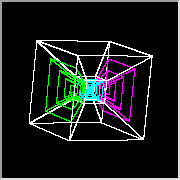Home
> 4D Maze Game
Download
|
The Idea
In the Maze
> Notes
Reference
The Fourth Dimension
Can You See It?
|
The Tesseract
The Tesseract, Part Two
The Hexadecachoron
|
How Much Space Is There?
Rotations
How to Point
How to Orient Yourself
Volumes
Walls Are Opaque
|
|
> Some Mathematics |
Some Mathematics
As I said earlier, I've always wanted to be able to visualize four-dimensional objects. But why? Why would I want to visualize them, and why would I even be thinking about them in the first place?Part of the reason, I'm sure, is that I've read some books and stories that in various ways concern four-dimensional worlds and objects.
Most of the reason, though, has to do with mathematics. When you're performing symbolic calculations, there's nothing in the symbols that restricts you to three dimensions. So, sometimes, the symbols you're interested in will happen to describe a four-dimensional object, and then you get tantalized—you have these beautiful symbols right in front of you, but you literally can't see what they mean. For example, you can graph a function of one variable on paper, and a function of two variables in space, but if you want to graph a function of three variables, you're stuck, unless you can visualize four-dimensional objects.
Of course, there's nothing in the symbols that restricts you to four dimensions, either, but there is a law of diminishing returns at work. Every number of dimensions has unique characteristics, but even so, some numbers are more interesting than others. From what I've seen, it's debatable whether three or four is more interesting, but it's pretty clear that five is less interesting than either, and that it goes rapidly downhill from there.
So, anyway, the point is, if you could visualize four-dimensional space, there are some wonderful mathematical objects you could see. Now I will tell you about a few of my favorites.
I suspect the first time I wanted to see a four-dimensional mathematical object was when I learned about complex numbers and functions. Suddenly the familiar sine and hyperbolic sine were revealed to be parts of a single function—and I couldn't see it, because it takes four dimensions to graph a complex function of a complex variable.
In other words, if you could see it, you could see how the familiar real-valued functions fit together. (The exponential is another one I'd really like to see.) You could see branch points and essential singularities. You could look at functions and see that they're analytic—being analytic looks like something! Maybe you could even look at polynomials and see why they always have exactly as many roots as they're supposed to!
Then there are matrices.
Matrices are especially tantalizing because normally you can't visualize them at all—the simplest type that isn't just a number or a vector is a real-valued 2 × 2 matrix, and already that takes four numbers, or coordinates, to describe. But, if you could see it, you could see 2 × 2 matrices as points in four-dimensional space. Multiplication of a matrix or two-component vector by another matrix would have a geometric meaning, and look like something. I'd be surprised if the meaning were simple, but at least you could see it.
Even better, you could see whole sets of matrices all at once. The sets that are algebraic groups are particularly nice. The set of matrices with determinant 1 is a three-dimensional surface; that's the group SL(2). The set of rotation matrices is a circle, and the set of reflection matrices is another; the first is the group SO(2), and the two together form the group O(2). And, as a subset of SL(2), the circles are linked! (Circles can't be linked in four-dimensional space.)
What about complex-valued matrices? Well, if you're willing to consider 1 × 1 matrices, there is actually an interesting group you can visualize—the group U(1) is just the unit circle in the complex plane. It is the same as the group SO(2).
When you get to 2 × 2 matrices, though, you're really stuck, because all of a sudden there are eight coordinates. However, there is an interesting special case: for matrices in the group SU(2), the second column is entirely determined by the first, so a nice four-dimensional projection is possible. And, as it happens, that projection is the unit 3-sphere! SU(2) is almost the same as the group SO(3) of three-dimensional rotation matrices.
Then there are some examples from physics. In special relativity, if you could see it, you could see the three dimensions of space and one dimension of time all at once—a whole (3+1)-dimensional space. (I'm particularly curious to see what light cones really look like.) In general relativity, that (3+1)-dimensional space becomes curved, a five-dimensional object, so you couldn't see it all at once, but you could see static behavior by looking at curved 3-dimensional surfaces, and dynamic behavior by looking at curved (2+1)-dimensional surfaces, and both of those would be very helpful.
Finally, there is one example that you can see in the maze game. In the geometry of surfaces, a two-dimensional surface is considered to be flat if it can be made from a piece of paper without distortion. You can roll paper up into a cylinder, so a cylinder is flat, but you can't bend a cylinder around to make a torus (doughnut) without crumpling the paper somewhere. However, that last is only true in three dimensions! In four dimensions, you can make a completely flat torus, as follows.
- Draw a circle that lies in the up-down-in-out plane.
- Extend it into a cylinder along the left-right axis.
- Bend it around to form a circle in the left-right-forward-backward plane.
You can also make a completely flat torus using squares instead of circles, and if you do, you get something we've already seen, namely, the boundary of this loop! (As before, the front face isn't shown.)

See Also
Bibliography
Can You See It?